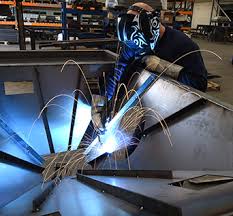
The Art of Fabrication in Welding: Crafting Precision and Quality
The Art of Fabrication in Welding
Welding is a skilled trade that involves joining materials, typically metals, using high heat to melt the parts together and allowing them to cool, resulting in a strong bond. One crucial aspect of welding is fabrication, which plays a significant role in creating structures and products that are essential in various industries.
Fabrication in welding involves the process of cutting, bending, and shaping metal materials to create components or structures according to specific designs and requirements. Skilled fabricators use their expertise to work with various types of metals, such as steel, aluminium, and stainless steel, to produce high-quality products.
One of the key elements of fabrication in welding is precision. Fabricators must meticulously follow blueprints or design specifications to ensure that the final product meets exact measurements and standards. This attention to detail is crucial in industries where precision is paramount, such as aerospace and automotive manufacturing.
Additionally, fabrication often requires a combination of welding techniques, such as MIG (Metal Inert Gas), TIG (Tungsten Inert Gas), or stick welding, depending on the type of metal being used and the specific requirements of the project. Skilled fabricators are proficient in these techniques and can choose the most suitable method for each job.
Furthermore, fabrication in welding goes beyond simply joining metal pieces together. It also involves processes like grinding, polishing, and finishing to ensure that the final product not only meets structural requirements but also looks aesthetically pleasing. This attention to detail sets skilled fabricators apart and adds value to their work.
In conclusion, fabrication is an essential part of welding that requires expertise, precision, and attention to detail. Skilled fabricators play a crucial role in creating structures and products that are vital across various industries. Their ability to work with different metals and employ various welding techniques makes them invaluable assets in the world of manufacturing and construction.
Common Queries About Welding in Fabrication: Methods, Processes, and Design
- Why do we use welding in fabrication?
- Which welding is used for fabrication?
- What is fabrication process?
- What is welding design and fabrication?
Why do we use welding in fabrication?
Welding is an indispensable process in fabrication due to its ability to join metal components together with strength and durability. By using welding techniques, fabricators can create complex structures and products that meet specific design requirements. Welding allows for the fusion of materials, ensuring a seamless bond that can withstand varying levels of stress and pressure. This crucial aspect of fabrication enables the production of customised items tailored to the needs of different industries, making welding an essential tool in the manufacturing and construction sectors.
Which welding is used for fabrication?
In the realm of fabrication in welding, the choice of welding method is a critical consideration that directly impacts the quality and efficiency of the final product. Various welding techniques are employed for fabrication, with popular options including MIG (Metal Inert Gas), TIG (Tungsten Inert Gas), and stick welding. The selection of the appropriate welding method depends on factors such as the type of metal being used, the thickness of the materials, and the specific requirements of the project. Skilled fabricators possess a deep understanding of these different welding processes and can expertly choose the most suitable technique to ensure precise and durable results in fabrication projects.
What is fabrication process?
The fabrication process in welding refers to the methodical sequence of tasks involved in shaping and assembling metal materials to create a final product or structure. It encompasses a range of activities such as cutting, bending, welding, and finishing, all aimed at transforming raw materials into functional components according to specific design requirements. Skilled fabricators meticulously follow detailed plans and blueprints to ensure precision and accuracy throughout the fabrication process. By combining expertise in welding techniques with a keen eye for detail, fabricators bring designs to life through their craftsmanship and dedication to producing high-quality workpieces.
What is welding design and fabrication?
Welding design and fabrication encompass the intricate process of conceptualising, planning, and creating metal structures or components through welding techniques. Welding design involves the initial phase of visualising the final product, considering factors such as material selection, structural integrity, and functionality. Fabrication, on the other hand, focuses on bringing this design to life by cutting, shaping, and welding metal pieces together to form the desired structure. The synergy between welding design and fabrication is essential in producing high-quality products that meet specific requirements and standards in various industries.
